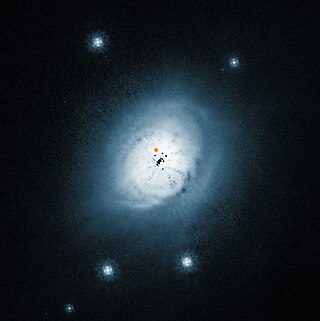
HD 100546, also known as KR Muscae, is a pre-main sequence star of spectral type B8 to A0 located 353 light-years from Earth in the southern constellation of Musca. The star is surrounded by a circumstellar disk from a distance of 0.2 to 4 AU, and again from 13 AU out to a few hundred AU, with evidence for a protoplanet forming at a distance of around 47 AU.

Z Canis Majoris (Z CMa) is a B-type star in the constellation of Canis Major. It has an average apparent visual magnitude of approximately 10, though has brightened by 1-2 magnitudes in irregular outbursts in 1987, 2000, 2004 and 2008.
HD 97048 or CU Chamaeleontis is a Herbig Ae/Be star 603 ly away in the constellation Chamaeleon. It is a variable star embedded in a dust cloud containing a stellar nursery, and is itself surrounded by a dust disk.
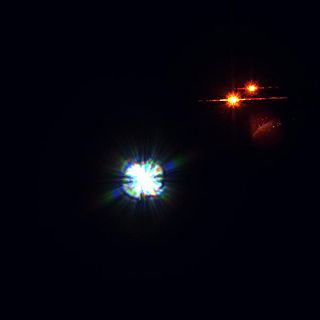
HD 141569 is an isolated Herbig Ae/Be star of spectral class A2Ve approximately 364 light-years away in the constellation of Libra. The primary star has two red dwarf companions at about nine arcseconds. In 1999, a protoplanetary disk was discovered around the star. A gap in the disk led to speculation about a possible extrasolar planet forming in the disk.
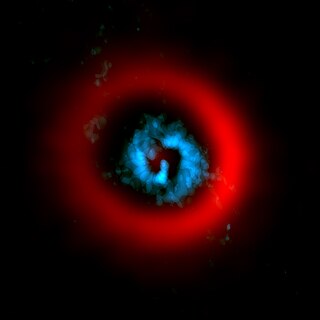
AB Aurigae is a young Herbig Ae star in the Auriga constellation. It is located at a distance of approximately 531 light years from the Sun based on stellar parallax. This pre-main-sequence star has a stellar classification of A0Ve, matching an A-type main-sequence star with emission lines in the spectrum. It has 2.4 times the mass of the Sun and is radiating 38 times the Sun's luminosity from its photosphere at an effective temperature of 9,772 K. The radio emission from the system suggests the presence of a thermal jet originating from the star with a velocity of 300 km s−1. This is causing an estimated mass loss of 1.7×10−8 M☉ yr−1.

HD 142527 is a binary star system in the constellation of Lupus. The primary star belongs to the Herbig Ae/Be star class, while the companion, discovered in 2012, is a red dwarf star or accreting protoplanet with a projected separation of less than 0.1″. The system is notable for its circumbinary protoplanetary disk and its discovery has helped refine models of planet formation. The orbit of companion is strongly inclined to the circumbinary protoplanetary disk.
SAO 206462 is a young star, surrounded by a circumstellar disc of gas and clearly defined spiral arms. It is situated about 440 light-years away from Earth in the constellation Lupus. The presence of these spiral arms seems to be related to the existence of planets inside the disk of gas surrounding the star. The disk's diameter is about twice the size of the orbit of Pluto.

HD 259431 is a young stellar object in the constellation of Monoceros.
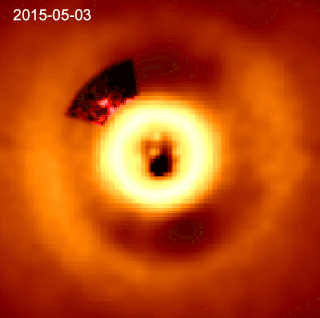
HD 169142 is a single Herbig Ae/Be star. Its surface temperature is 7650±150 K. HD 169142 is depleted of heavy elements compared to the Sun, with a metallicity Fe/H index of −0.375±0.125, but is much younger at an age of 7.5±4.5 million years. The star is rotating slowly and has relatively low stellar activity for a Herbig Ae/Be star.

GW Orionis is a T Tauri type pre-main sequence hierarchical triple star system. It is associated with the Lambda Orionis star-forming region and has an extended circumtrinary protoplanetary disk.

HD 36112, also known as MWC 758, is a young Herbig Ae star located in the constellation Taurus, surrounded by irregular rings of cosmic dust. The system is about 3.5 million years old. The disk has a cavity at 50 astronomical units and two spiral arms at 30-75 au that are seen in near-infrared scattered light, but only one spiral arm is seen in ALMA images.

AK Scorpii is a Herbig Ae/Be star and spectroscopic binary star about 459 light-years distant in the constellation Scorpius. The star belongs to the nearby Upper Centaurus–Lupus star-forming region and the star is actively accreting material. The binary is surrounded by a circumbinary disk that was imaged with VLT/SPHERE in scattered light and with ALMA.

RY Tauri is a young T Tauri star in the constellation of Taurus about 450 light years away, belonging to the Taurus Molecular Cloud. It is more massive than typical T Tauri stars, and may be an intermediate between this class and the Herbig Ae/Be star type.
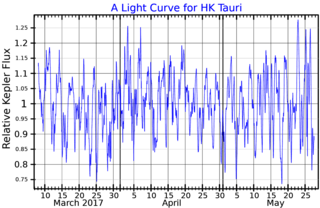
HK Tauri is a young binary star system in the constellation of Taurus about 434 light-years away, belonging to the Taurus Molecular Cloud.

HD 150193 is a binary star system in the constellation of Ophiuchus. The primary star was identified as a Herbig Ae/Be star with a strong solar wind, losing approximately a tenth of solar mass per million years. It does host a very small debris disk, likely due to disk truncation by the nearby stellar companion. The disk is inclined 38±9° to the plane of sky. It appears to be highly evolved and asymmetric, with indications of flattening and grains growth.

DL Tauri is a young T Tauri-type pre-main sequence stars in the constellation of Taurus about 522 light years away, belonging to the Taurus Molecular Cloud. It is partially obscured by the foreground gas cloud rich in carbon monoxide, and is still accreting mass, producing 0.14 L☉ due to release of accretion energy. The stellar spectrum shows the lines of ionized oxygen, nitrogen, sulfur and iron.
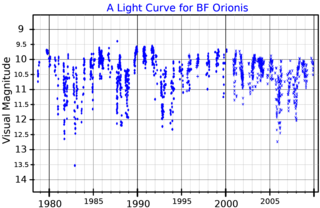
BF Orionis is a young Herbig Ae/Be star in the constellation of Orion about 1250 light years away, within the Orion Nebula. It is the most massive star of the small birth cluster of four stars.
HD 100453 is a binary star system which lies in the constellation Centaurus about 350 light years away from the Sun and is a member of the open cluster Scorpius–Centaurus association.

CQ Tauri is a young variable star in the equatorial constellation of Taurus. It is too faint to be visible to the naked eye with an apparent visual magnitude that ranges from 8.7 to 12.25. The distance to this star is approximately 487 light years based on parallax measurements, and it is drifting further away with a radial velocity of ~23 km/s. It appears to be part of the T-association Tau 4. CQ Tauri lies close enough to the ecliptic to undergo lunar occultations.

IM Lupi is a young stellar object with a surrounding protoplanetary disk. The young star is suspected to host a still forming protoplanet at a distance of 110 astronomical units (AU) and a mass of 2-3 MJ. IM Lupi is 508 light-years distant.


















